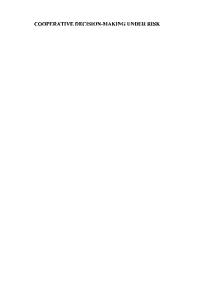Decisions under risk: Dispersion and skewness
- PDF / 1,453,358 Bytes
- 24 Pages / 439.37 x 666.142 pts Page_size
- 119 Downloads / 330 Views
Decisions under risk: Dispersion and skewness Oben K. Bayrak 1 & John D. Hey 2 Published online: 25 November 2020 # Springer Science+Business Media, LLC, part of Springer Nature 2020
Abstract When people take decisions under risk, it is not only the expected utility that is important, but also the shape of the distribution of utility: clearly the dispersion is important, but also the skewness. For given mean and dispersion, decision-makers treat positively and negatively skewed prospects differently. This paper presents a new behaviourally-inspired model for decision making under risk, incorporating both dispersion and skewness. We run a horse race of this new model against six other models of decision making under risk and show that it outperforms many in terms of goodness of fit and shows a reasonable performance in predictive ability. It can incorporate the prominent anomalies of standard theory such as the Allais paradox, the valuation gap, and preference reversals, and also the behavioural patterns observed in experiments that cannot be explained by Rank Dependent Utility Theory. JEL Classification D81 Keywords Decision under risk . Dispersion . Skewness . Non-expected utility . Pairwise
choice . Stochastic specifications . Anomalies
* Oben K. Bayrak [email protected] John D. Hey [email protected]
1
Centre for Environmental and Resource Economics (Umeå, Sweden) and Department of Economics, University of Gothenburg, Gothenburg, Sweden
2
Department of Economics and Related Studies, University of York, Heslington, York YO10 5DD, UK
Journal of Risk and Uncertainty (2020) 61:1–24
2
1 Introduction We present a new model of decision making under risk. Crucial to our story is that the decision-maker (henceforth DM) considers not only the expected utility of a lottery, but also the dispersion and skewness of the utilities. Our new theory explains how an individual values lotteries and hence takes decisions under risk. The theory is based on a behavioural description of the evaluation process. In this theory, evaluation is thought of as a two-stage process: first, the DM formulates an interval for the value of each lottery; secondly, the DM takes a weighted average of the extremes of this interval. Crucially, the interval depends upon the dispersion of the lottery, while the weights in the weighted average depend upon the skewness of the lottery and the optimism/pessimism of the individual. Let us break this down into its two stages. As to the first stage, the literature suggests that many individuals find it difficult to state a precise Willingness-to-Pay (WTP) or Willingness-to-Accept (WTA) for a good (Bayrak and Kriström 2016; Dubourg et al. 1994, 1997; Morrison 1998). Studies show that if subjects are given the option of stating their subjective valuations in terms of a single amount or an interval, more than half of subjects prefer to state their valuations in terms of an interval (Banerjee and Shogren 2014; Håkansson 2008; Bayrak and Kriström 2016). However, because of the problems in incentivi
Data Loading...











